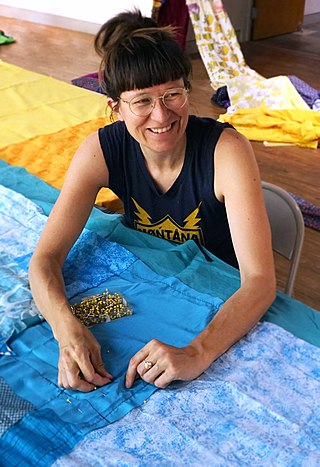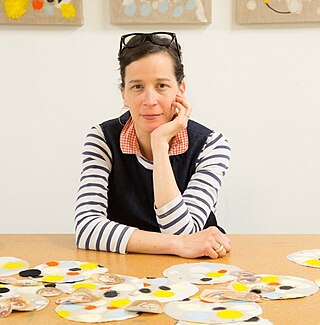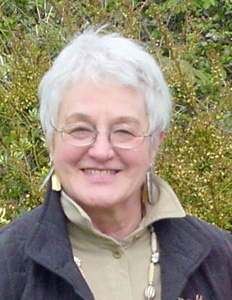Related Research Articles

Quilting is the process of joining a minimum of three layers of fabric together either through stitching manually using a needle and thread, or mechanically with a sewing machine or specialised longarm quilting system. An array of stitches is passed through all layers of the fabric to create a three-dimensional padded surface. The three layers are typically referred to as the top fabric or quilt top, batting or insulating material, and the backing.

A quilt is a multi-layered textile, traditionally composed of two or more layers of fabric or fiber. Commonly three layers are used with a filler material. These layers traditionally include a woven cloth top, a layer of batting or wadding, and a woven back combined using the techniques of quilting. This is the process of sewing on the face of the fabric, and not just the edges, to combine the three layers together to reinforce the material. Stitching patterns can be a decorative element. A single piece of fabric can be used for the top of a quilt, but in many cases the top is created from smaller fabric pieces joined, or patchwork. The pattern and color of these pieces creates the design. Quilts may contain valuable historical information about their creators, "visualizing particular segments of history in tangible, textured ways".

Appliqué is ornamental needlework in which pieces or patches of fabric in different shapes and patterns are sewn or stuck onto a larger piece to form a picture or pattern. It is commonly used as decoration, especially on garments. The technique is accomplished either by hand stitching or machine. Appliqué is commonly practised with textiles, but the term may be applied to similar techniques used on different materials. In the context of ceramics, for example, an appliqué is a separate piece of clay added to the primary work, generally for the purpose of decoration.
Marie Watt is a contemporary artist living and working in Portland, Oregon. Enrolled in the Seneca Nation of Indians, Watt has created work primarily with textile arts and community collaboration centered on diverse Native American themes.

Fiber art refers to fine art whose material consists of natural or synthetic fiber and other components, such as fabric or yarn. It focuses on the materials and on the manual labor on the part of the artist as part of the works' significance, and prioritizes aesthetic value over utility.

Ghada Amer is a contemporary artist, much of her work deals with issues of gender and sexuality. Her most notable body of work involves highly layered embroidered paintings of women's bodies referencing pornographic imagery.

Pat Steir is an American painter and printmaker. Her early work was loosely associated with conceptual art and minimalism, however, she is best known for her abstract dripped, splashed and poured "Waterfall" paintings, which she started in the 1980s, and for her later site-specific wall drawings.
Sewing is the craft of fastening or attaching objects using stitches made with needle and thread. Sewing is one of the oldest of the textile arts, arising in the Paleolithic Era. Although usually associated with clothing and household linens, sewing is used in a variety of crafts and industries, including shoemaking, upholstery, sailmaking, bookbinding and the manufacturing of some kinds of sporting goods. Sewing is the fundamental process underlying a variety of textile arts and crafts, including embroidery, tapestry, quilting, appliqué and patchwork.
Nancy Grossman is an American artist. Grossman is best known for her wood and leather sculptures of heads.
Keith A. Smith is an American artist and author. He has taught at the Visual Studies Workshop, the School of the Art Institute of Chicago, and the University of Illinois. He is a recipient of two Guggenheim Fellowships, a National Endowment of the Arts grant and a Pollock-Krasner Foundation grant. Smith creates books as works of art, as well as instructional texts on how to make books. Permanent collections which hold works by Smith include the National Gallery of Art, Museum of Modern Art, the National Gallery of Canada, and the Center for Creative Photography.
Carol Wax is an American artist, author and teacher whom the New York Times called "a virtuoso printmaker and art historian" for her work in mezzotint and her writings on the history and technique of that medium.
Elaine Reichek is a New York-based visual artist. Much of her work concerns the history of the embroidered sampler. Through her pieces of hand and machine embroidery and digital sewing machine, she addresses issues such as the craft/art and the old/new divide, the nature of women's work, and the interplay of text and image. The connection between the pixel and the stitch, as differently gendered types of mark-making, is a continuing theme in her work.

Magna Carta (An Embroidery) is a 2015 work by English installation artist Cornelia Parker. It is an embroidered representation of the complete text and images of an online encyclopedia article for Magna Carta, as it appeared on the English Wikipedia on 15 June 2014, the 799th anniversary of the document.
Barbara Lee Smith is an American mixed media artist, writer, educator, and curator. She creates large scale landscapes and abstract works using a three step process of painting, collage, and machine stitching.

Angela Su is a Hong Kong artist known for her biomorphic drawings, fictional films and hair embroideries, exploring the imagery of the body through metamorphosis, hybridity and transformation. She is a trained biochemist as well as a visual artist. In 2014, Su was featured in Art Radar on a list of influential Asian female artists making an impact on the international art stage. She represents Hong Kong in the Collateral Event at the 59th International Art Exhibition - La Biennale di Venezia, with a solo exhibition titled: Angela Su: Arise, Hong Kong in Venice.
Rebecca Ringquist is a Portland, Oregon-based visual artist. Ringquist creates embroidered artwork and runs her own design company, Dropcloth Samplers. Her work extends the traditional processes of Fiber art by dealing with vintage fabrics, utilizing the sewing machine, and applying hand-embroidery techniques. Ringquist was a professor for seven years in the Department of Fiber and Material Studies at The School of the Art Institute of Chicago. She is also the author of Rebecca Ringquist's Embroidery Workshops: A Bend the Rules Primer.

Amanda Browder is an American installation artist known for her large-scale fabric installations on building exteriors and other public sites. Her work incorporates donated materials and local volunteers, creating site-specific art. She is the recipient of grants from the National Endowment for the Arts, and Transformation Fellowship from the University of Nevada, Las Vegas (UNLV).

Diana Guerrero-Maciá is an American studio-based artist who has produced paintings, works on paper, prints and sculpture. She is known for her hybrid or "unpainted paintings"—works constructed with fabric cutwork, collage, stitching and dye that collapse boundaries between the fields of painting, fiber and design and challenge distinctions between "high" art and craft. Her largely abstract work samples and revises multiple materials, symbols and typography, and graphic elements such as grids, stripes and archetypal shapes to engage with color, iconography and diverse cultural movements and conventions.

Audrey Walker was an accomplished textile artist, embroiderer and teacher, who was active from the 1970s and 1990s in United Kingdom. Walker became known for developing an innovative style of embroidery based on fine threads applied by machine and by hand, to create striking figurative wall-hung works of art. Walker described her work as evolving from fairly fluid ideas, and the process as being akin to drawing with fabrics.

Donna Ruff is an American visual artist, curator and educator currently living and working in Miami, Florida. She works in mixed media on found printed matter, primarily newspaper headline pages and historical documents. Ruff questions how written and photographic narratives are constructed by removing and transforming printed text and image to recontextualize the portrayal of world events.
References
- 1 2 North, Bill, ["Under Her Hands"], "Marianna Kistler Beach Museum of Art," October 2007
- ↑ Ostrower, Jessica, ["China Marks at Luise Ross] "Art in America," February 2005
- ↑ Berens, Joshua, ["Some Jazzy Stitches by China Marks] "W.I.S.H Poetry Press," January 2014
- ↑ [ permanent dead link ]
- ↑ Marks, China and Hicks, H.L. ["To Give Ourselves Over: A Conversation"], Numero Cinq Magazine, Volume IV, Number 3," March 2103
Bibliography
- Berens, Joshua, “Some Jazzy Stitches by China Marks”, "W.I.S.H Poetry Press," January 2014
- Marks, China, “Knee-deep in a Sea of Tears: Hybrid Drawings” "Numero Cinq Magazine, Volume IV, Number 9," September 2013
- Sonnenberg, Rhonda, “The Sewn Drawings of China Marks”, "Fiberarts," September/October 2005
- Bogosh, Sarah, “China Marks: Drawing with Fabric and Print,” interview, "Anchor Graphics, Columbia College, Chicaho, Volume 5, Number 1," Summer/Fall 2011